Introduction
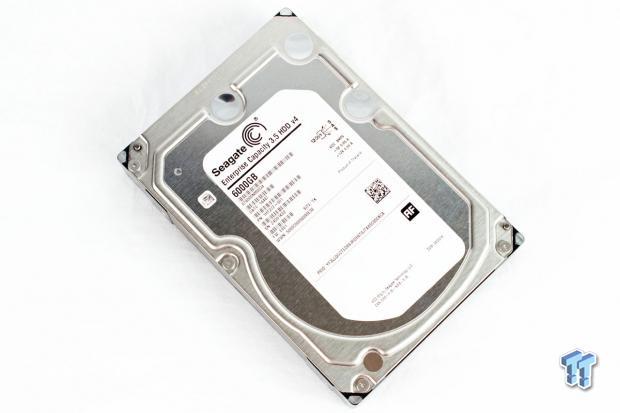
Today we have the first 12Gb/s SAS HDD in our labs for testing, Seagate's 6TB nearline Enterprise Capacity 3.5 HDD v4. A few months ago, Seagate brought an entire family of 7,200 RPM drives in capacities of 6, 5, 4 and 2TB drives to the familiar 3.5" form factor, and these new drives have the option of a dual-port 12GB/s connection or SATA 6Gb/s.
Seagate's 8th generation 6TB Enterprise Capacity v4 HDD's has 6 platters spinning at 7,200 RPM. The drive features a jump in areal density to 643 Gbits/sq. inch, the new advanced format, and 2 additional platters and 2 additional heads. This boosts capacity to 6TB, a 50% increase.
Nearline SAS HDDs provide an enhanced feature set for a small price premium. Nearline SAS drives feature the same media, heads, and rotational speed of typical SATA HDD. The addition of the SCSI command set adds enhanced management features, and dual port functionality provides multi-path and failover capabilities. 12Gb/s SAS also supports TCQ and a larger command queue. The 6Gb/s SAS interface is actually faster than SATA (by 20%) because there is no need for the STP (Serial ATA Tunneling Protocol) overhead. Seagate chose to provide even more performance with a 12Gb/s connection.
Many have questioned the wisdom of 12Gb/s SAS for hard disk drives that lack the speed to push the interface. In fact, HGST stayed with 6Gb/s SAS on the He6, which is currently the only other 6TB drive on the market. One reason to make the immediate move to 12Gb/s is to ensure forward compatibility with new RAID controllers and HBAs, and another reason is if you plan to deploy an SSHD.
The SAS v4 we have in the labs has mounting points for a NAND package on the PCB, denoting a future SSHD product. There is also another mount point that is very likely for an SSD controller. This type of implementation will require more bandwidth for situations where the HDD is communicating directly from NAND and 12Gb/s SAS fits the bill nicely. The advent of new dense NAND solutions can cram up to 128GB of flash into one package, and future 3D NAND technologies will pack up to a terabyte on a single chip. Increasing NAND density provides Seagate with a path for even more performance for their SSHD initiative, which provides huge performance benefits as noted in our Seagate Enterprise Turbo SSHD Review.
Seagate will not officially confirm a pending SSHD revision, but the striking similarity to SSHD designs we tested in the past is unavoidable. We have a more detailed analysis on the following page.
The Seagate v4 supports Super Parity, which adds an extra parity bit to improve data integrity for data at rest. In conjunction with enhanced error correction the v4 features a standard error rate of 1 per 10^15. The v4's MTBF is rated for 1.4 million hours (an AFR of 0.63%) while handling nearline workloads of 550TB.
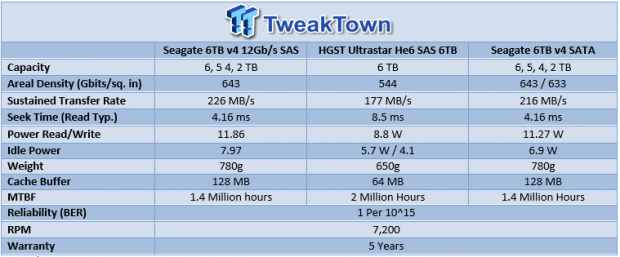
The maximum sustained transfer rate of the SAS Seagate v4 is 226 MB/s, an increase of 10 MB/s over the SATA variant. The 12Gb/s SAS v4 features the same seek time of 4.16ms, and features a 128MB multi-segmented cache buffer.
One of the more notable changes in the SAS-powered v4 is the increase in power consumption. 12Gb/s SAS is a much faster interface with dual ports that requires more power for operation. The typical operating power of the SATA v4 is 11.27W, the same as their previous generation Constellation ES.3. The SAS version bumps that up to 11.87 Watts, but also matches the power consumption of the previous generation ES.3 SAS HDDs.
The SAS Seagate v4 exhibits a marked improvement of 1.98W-per-TB, compared to 2.96W-per-TB for the ES.3. The only slight increase over the ES.3 is idle power; from 7.8W to 7.97W.
The Seagate Enterprise Capacity v4 with the SATA interface was a great entrant into the high-capacity space. Let's take a closer look at the SAS variant.
Seagate Enterprise Capacity v4 Internals and Specifications
Seagate 6TB Enterprise Capacity 3.5 HDD v4 Internals

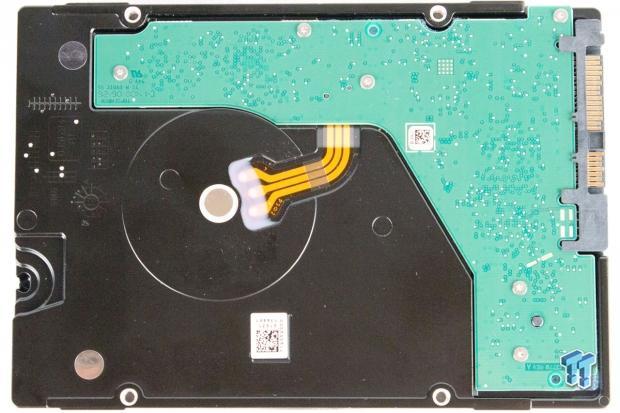
The 12Gb/s SAS Seagate Enterprise Capacity 3.5 HDD v4 comes in the 3.5" form factor. The breather hole to the upper left of the Seagate logo reminds us of the v4's standard drive architecture. The Seagate v4 has a humidity sensor that detects when the drive is above spec and alerts the user. The v4 features ramp load technology and a top-cover attached motor.


The foam covering rests between the PCB and the drive to absorb vibration. Thermal pads cover the controller and motor controller to shed heat into the case of the drive. There is a sheer plastic cover over three rows of capacitors on the right edge of the PCB.
Most importantly there are two big mounting pads on the slender end of the PCB. The PCB for the SAS version of the 6TB Seagate is longer on this portion of the PCB, and the SATA version does not have these mounting pads. One pad, the X shaped pad on the end, is undoubtedly for a NAND package, indicating a strong likelihood of a future SSHD version of this drive. The square pad next to it is likely for an additional controller for NAND management, especially in light of the PCB traces routing from the NAND package directly to the adjacent mount points.
The previous Turbo SSHD from Seagate utilized the standard drive controller for caching operations, but bringing another controller onto the drive would offer much more performance, and also more robust caching and tiering algorithms. Using the same controller for drive and NAND operations remains quite the feat but this could become more challenging with more NAND capacity. Management of more LBA's requires more FTL (Flash Translation Layer) horsepower, and it is doubtful there will be the inclusion of an additional cache chip for LBA mapping purposes. A SandForce controller variant would make a great fit for this architecture because they do not require DRAM caching for LBA management. An additional DRAM chip would be difficult due to space and power constraints.
Seagate just purchased SandForce from Avago recently, but Avago had just purchased SandForce from LSI, who also happens to manufacture the other controller on this HDD. We expect some integration of the product stacks in the future, and this could have been just one more reason for Seagate to pick up SandForce. Of course, this is all wild speculation and Seagate has not confirmed a SSHD version.

This image is from the Seagate Turbo SSHD article we posted a few months ago. Seagate used the PCB from the standard 15K HDD (on the left) with the same X shaped NAND mounting pad, but added a NAND package for the SSHD version (on the right). This at least confirms the same NAND mounting scheme.


The LSI TT50692 controller sets next to the 128MB Winbond multi-segmented cache module.
The SK Hynix memory chip offers 128MB of multi-segmented cache. The SMOOTH drive motor controller resides to the bottom of the PCB. Two accelerometers occupy opposing sides of the PCB to detect and help counteract drive movement and vibration. The Seagate v4 touts industry-leading rotational vibration tolerance.

Idle power consumption is a pain point in the datacenter. The Seagate Enterprise Capacity v4 utilizes PowerChoice Technology. PowerChoice provides 4 enhanced idle modes that place the drive into deeper quasi-sleep cycles to conserve power. In a typical implementation, the feature is enabled with a SAS Mode Page or SATA Set Feature command. Once enabled, PowerChoice places the drive into successively deeper idle states triggered by the length of drive inactivity. There is also the option for immediate host-initiated power transitions with SAS/SATA commands. Each consecutive sleep mode requires more time for resumption. We test idle power consumption without PowerChoice activated, so there is an option for even lower idle power consumption.
We tested idle power and measured the SAS v4 at 9.8 Watts, the SATA v4 at 9.1 Watts, and the He6 at 7 and 5.4-5.5 Watts during deeper sleep intervals. SAS typically consumes more power than SATA, so the higher power draw is expected. SAS is a dual-port full-duplex connection that allows read and write activity simultaneously, resulting in the higher power draw.
Seagate v4 Specifications
The Seagate v4 comes in 4KN and 512E flavors, and offers SED models (AES-256) with ISE (Instant Secure Erase). ISE eases drive retirement and repurposing by eliminating the need for physical destruction. Seagate SED drives are typically the same price as standard drives. There is also an SED-FIPS 140-2 model available. The SED-FIPS version is only available at the 6TB capacity point. Seagate is the only drive manufacturer that offers SED-FIPS drives with tamper-evident coverings.

Test System and Methodology


Our approach to storage testing targets long-term performance with a high level of granularity. Many testing methods record peak and average measurements during the test period. These average values give a basic understanding of performance, but fall short in providing the clearest view possible of I/O QoS (Quality of Service).
'Average' results do little to indicate performance variability experienced during actual deployment. The degree of variability is especially pertinent, as many applications can hang or lag as they wait for I/O requests to complete. This testing methodology illustrates performance variability, and includes average measurements, during the measurement window.
While under load, all storage solutions deliver variable levels of performance. While this fluctuation is normal, the degree of variability is what separates enterprise storage solutions from typical client-side hardware. Providing ongoing measurements from our workloads with one-second reporting intervals illustrates product differentiation in relation to I/O QOS. Scatter charts give readers a basic understanding of I/O latency distribution without directly observing numerous graphs.
Consistent latency is the goal of every storage solution, and measurements such as Maximum Latency only illuminate the single longest I/O received during testing. This can be misleading, as a single 'outlying I/O' can skew the view of an otherwise superb solution. Standard Deviation measurements consider latency distribution, but do not always effectively illustrate I/O distribution with enough granularity to provide a clear picture of system performance. We utilize high-granularity I/O latency charts to illuminate performance during test runs.
We measure power consumption during precondition runs. This provides measurements in time-based fashion, with results every second, to power consumption behavior. We also present IOPS-to-Watts measurements to highlight efficiency. The first page of results will provide the 'key' to understanding and interpreting our test methodology.
Benchmarks - 4k Random Read/Write
4k Random Read/Write
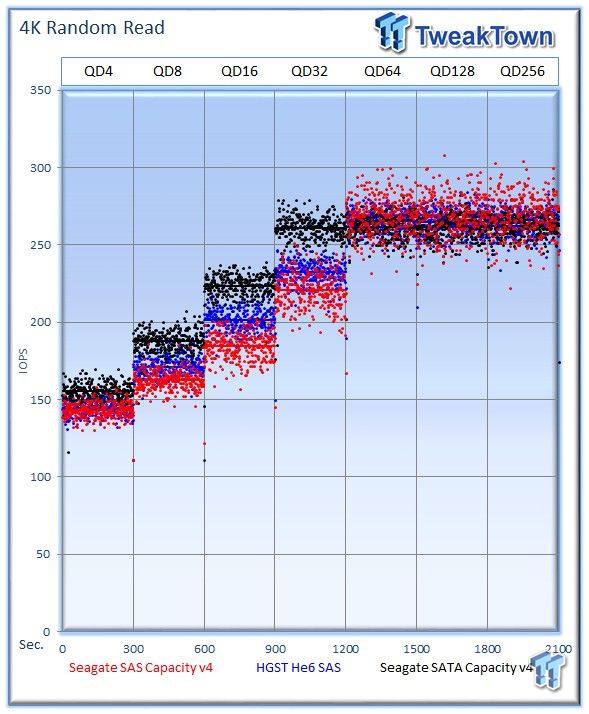
Each level tested includes 300 data points (five minutes of one second reports) to illustrate performance variability. The line for each queue depth represents the average speed reported during the five-minute interval. 4K random speed measurements are an important metric when comparing drive performance, as the hardest type of file access for any storage solution to master is small-file random. One of the most sought-after performance specifications, 4K random performance is a heavily marketed figure.
The 12Gb/s SAS Seagate Enterprise Capacity 3.5 HDD v4 averages 255 IOPS at QD256, the SAS HGST Ultrastar He6 averages 264 IOPS at QD256, while the SATA v4 averages 262 IOPS. The SAS He6 is faster than the Seagate SAS v4 in this random read test. This was not the case with the Seagate SATA v4, which easily led the HGST SATA He6.

The SAS v4 provides the lowest latency.

The write workload also yields an unexpected change to the results we observed in the original SATA v4 article. The SAS v4 averages 265 IOPS at QD256, the SAS He6 averages 248 IOPS, and the SATA v4 averages 289 IOPS. The SAS v4 leads the test, but it is apparent there is a slight performance reduction compared to its SATA sibling. The SAS He6 is also faster than its SATA counterpart, which only averaged 234 IOPS in the same test.

All three drives deliver optimum performance-to-latency ratios at lower queue depths.

Our write percentage testing illustrates the varying performance of each solution with mixed workloads. The 100% column to the right is a pure write workload of the 4k file size, and 0% represents a pure 4k read workload.
The SAS v4 lags slightly behind its SATA counterpart, but is well above the SAS He6.

We record power consumption measurements during our test run at QD256. The SAS V4 averages 10.17 Watts, the He6 averages 7.11 Watts, and the SATA v4 averages 9.53 Watts. The SAS v4 exhibits an expected incremental increase in power consumption due to its dual-port connection. The He6 demonstrates elite power consumption that is nearly the same as the 7.03 Watts consumed by the SATA variant.


We generate IOPS-to-Watts measurements from data recorded during the test period. Our 4k write results indicate a win for the He6 in efficiency with an average of 34 IOPS per Watt. In our 4k read test, the SAS v4 averages 25 IOPS per Watt, the He6 averages 34 IOPS-per-Watt, and the SATA v4 measures 24 IOPS-per-Watt. The SAS He6 is actually more efficient than the SATA version due to slightly higher performance.
Benchmarks - 8k Random Read/Write
8k Random Read/Write

Server workloads rely heavily upon 8k performance and we include this as a standard with each evaluation. Many of our server tests also measure 8k performance with various mixed read/write workloads.
The average 8k random read speed of the 12Gb/s SAS Seagate Enterprise Capacity v4 averages 264 IOPS at QD256, SATA v4 tops out at 260 IOPS, and the SAS HGST Ultrastar He6 averages 262 IOPS. This is 37 IOPS faster than the SATA He6, and again signifies just how much faster the SAS He6 is in these workloads.


The SAS v4 averages 280 IOPS, the SATA v4 leads with an average of 289 IOPS at QD256, and the He6 offers up a considerably slower 232 IOPS.


The SATA v4 once again takes the lead as we mix in more write activity.

Power consumption for the SAS v4 averages 10.8 Watts, the He6 averages a miserly 7.6 Watts, and the SATA v4 averages 10.5 Watts.


All three drives fall into a predictable profile for read and write power efficiency, with the SAS and SATA v4 at the bottom and the He6 occupying the top of the charts.
Benchmarks - 128k Sequential Read/Write
128k Sequential Read/Write

We write to every LBA on both drives to highlight performance degradation from the outer to inner tracks of the drives. The drives begin with much higher speed on the outer tracks. The He6 requires 11 ½ hours to write the entire 6TB of data, but the SAS v4 is considerably faster, completing the task in roughly 9 hours, and the SATA v4 completes the task in 9.5 hours.
The SAS v4 has a 10MB/s advantage over the SATA v4 in sustained transfer speed, allowing it to finish the workload in a shorter amount of time. This increase is apparent in the faster completion time in this test; however, the incremental increase did not show up in short workload testing.

128k sequential speed reflects the maximum sequential throughput of the HDD. The SAS v4 averages 190 MB/s, the SATA v4 wins with an average of 192 MB/s and also exhibits the same tight performance profile. The He6 follows with an average of 158 MB/s.

The Seagate v4 provides lower latency across the board with sequential read activity.

The SAS v4 averages 190 MB/s, the SATA v4 leads with an average of 192 MB/s, and the He6 averages 159 MB/s.


The SAS and SATA v4 leads the mixed sequential testing, running away with the win in every category.

The SAS v4 averages 10.9 Watts, the SATA v4 averages 9.67 Watts, and the He6 averages a flat 7.11 Watts.


The HGST He6 continues to lead our efficiency metrics due to its very low power consumption.
Benchmarks - Database/OLTP and File Server
Database/OLTP

This Database and On-Line Transaction Processing (OLTP) workload is the processing of transactions such as credit cards and high frequency trading in the financial sector. Databases are the bread and butter of many enterprise deployments. These demanding 8k random workloads with a 66 percent read and 33 percent write distribution bring even the best solutions down to earth.
The SAS v4 provides 288 IOPS, the SATA v4 averages 282 IOPS, and the He6 weighs in with 264 IOPS. The SAS He6 is actually 29 IOPS faster than the SATA He6 model.


The SAS v4 requires 10.47 Watts, the SATA v4 averages 10.08 Watts, and the He6 averages 6.85 Watts.

The two Seagate v4's are close together at 27/28 IOPS per Watt, but the He6 distances itself from the crowd with an average of 36 IOPS per WATT.
File Server

The file server workload tests a wide variety of different file sizes simultaneously, with an 80% read and 20% write distribution.
The SAS v4 averages 250 IOPS at QD256, the SATA v4 averages 254 IOPS at QD256, and the He6 delivers an average of 261 IOPS.


The SAS V4 averages 10.77 Watts, the SATA v4 averages 10.5 Watts, and the He6 averages of 7.49 Watts.
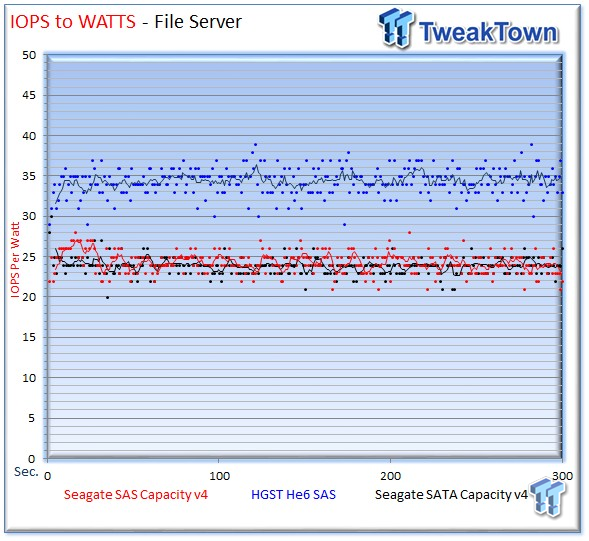
The He6 leads the chart once again in efficiency.
Benchmarks - Email Server
Email Server

The email server workload is a demanding 8K test with a 50% read and 50% write distribution. This application is indicative of the performance in heavy write workloads.
The SAS v4 averages 286 IOPS, the SATA v4 averages a leading 292 IOPS, and the HGST Ultrastar He6 averages 256 IOPS.


The SAS v4 averages 10.4 Watts, the SATA v4 averages 9.8 Watts, and the He6 averages 7.6 Watts.

The He6 continues the theme of lower power consumption yielding excellent IOPS to Watts performance.
Final Thoughts
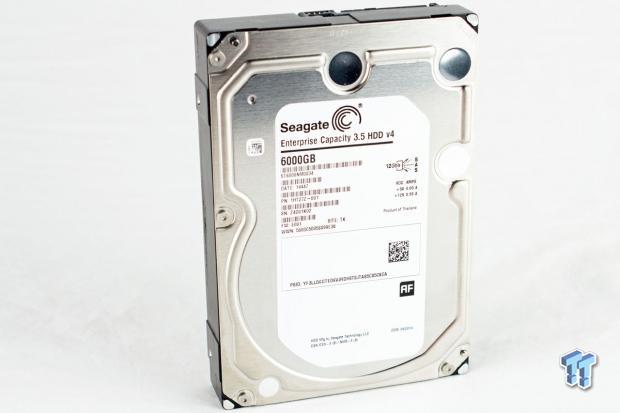
Nearline SAS has gained wide acceptance for capacity deployments due to its enhanced feature set and comparative pricing with SATA equivalents. Dual-port connections provide HA (High Availability) and a speedier interface. Seagate and HGST took different approaches in this respect. HGST went with the 6Gb/s SAS connection for the He6, while Seagate embedded the faster 12Gb/s SAS connection into the SAS Enterprise Capacity 3.5 HDD v4.
The faster speed of the 12Gb/s SAS connection seems to make sense given Seagate's obvious design preparations for an SSHD variant. The SATA Enterprise Capacity v4 does not include the same provisions for flash addition, leading us to speculate the SSHD version will be a high-powered SAS-only implementation.
The SAS v4 delivers tremendous performance, even without flash onboard, making it the fastest 6TB drive on the market. In random workloads, the SAS v4 exhibited a decrease of a few IOPS in high-load situations, but some of these results fall within expected performance variance. The difference might lie in the nearline nature of the 12Gb/s SAS connection.
The He6 features a native SAS connection that nets a big improvement in random workloads over its SATA equivalent. The increase of 37 IOPS in the OLTP workload over the SATA He6 is not small by any means, and we find the SAS-equipped HGST He6 to be more competitive than its SATA counterpart. This increase in performance did not result in any significant increase in power consumption, and actually increased the He6 power efficiency advantage.
The Seagate v4 retains the performance crown in spite of the increased random workload performance of the SAS He6. With sustained sequential workloads, we observed faster performance over long test periods in comparison to the SATA variant. The 10MB/s advantage was not present in shorter duration workloads. The Seagate v4 provides unmatched performance in mixed sequential workloads.
Overall, the Seagate v4 is the fastest 7,200 RPM drive available today, even with the big jump in random workloads from the SAS HGST He6. The He6 brings power advantages to the table, and for those optimizing for power-conscious environments the SAS He6 makes a much more compelling competitor than its SATA equivalent.
While the He6 provides the lowest possible power consumption, at the expense of some performance, the Seagate v4's power consumption is impressive as well. Power requirements per TB are important, and the V4 consumes only 1.98W per TB, a decrease from 2.96W per TB for previous generation ES.3 SAS drives. Administrators can effectively add 50% more capacity within the same power budget. Enabling PowerChoice idle power modes also supplies an advantage that can reduce idle power by 32% per TB.
The v4 also brings improvements in power-per-TB efficiency that easily beats any 4TB offering. Seagate has provided an entire family of drives instead of a single capacity point. This brings the same advantages, such as untouchable sequential speed, to a wider range of drives.
The SAS-powered Seagate Enterprise Capacity 3.5 HDD v4 brings enhanced functionality and a big jump in density. The impressive performance gains, and even increased power efficiency, in tandem with its five-year warranty, earns the TweakTown Editor's Choice Award.


 United
States: Find other tech and computer products like this
over at
United
States: Find other tech and computer products like this
over at  United
Kingdom: Find other tech and computer products like this
over at
United
Kingdom: Find other tech and computer products like this
over at  Australia:
Find other tech and computer products like this over at
Australia:
Find other tech and computer products like this over at  Canada:
Find other tech and computer products like this over at
Canada:
Find other tech and computer products like this over at  Deutschland:
Finde andere Technik- und Computerprodukte wie dieses auf
Deutschland:
Finde andere Technik- und Computerprodukte wie dieses auf